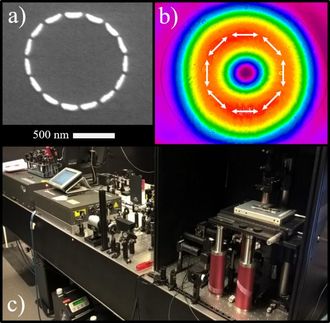Nanotechnology: DNA origami with cargo function
LMU chemists present two studies that open up new possibilities for biotechnological applications
In the world of nanotechnology, the development of dynamic systems that respond to molecular signals is becoming increasingly important. The DNA origami technique, whereby DNA is programmed so as to produce functional nanostructures, plays a key role in these endeavors. Teams led by LMU chemist Philip Tinnefeld have now published two studies showing how DNA origami and fluorescent probes can be used to release molecular cargo in a targeted manner.
In the journal Angewandte Chemie, the researchers report on their development of a novel DNA-origami-based sensor that can detect lipid vesicles and deliver molecular cargo to them with precision. The sensor works using single-molecule Fluorescence Resonance Energy Transfer (smFRET), which involves measuring the distance between two fluorescent molecules. The system consists of a DNA origami structure, out of which a single-stranded DNA protrudes, which has been labeled with fluorescent dye at its tip. If the DNA comes into contact with vesicles, its conformation changes. This alters the fluorescent signal, because the distance between the fluorescent label and a second fluorescent molecule on the origami structure changes. This method allows vesicles to be detected.
Sensor is transferred precisely
In a second step, the system can be used as a means of transporting molecules, with the sensing strand serving as molecular cargo that can be transferred to the vesicle. Through a further modification of the system, the researchers were also able to precisely control the transfer of the cargo.
Lipid vesicles play a key role in many cellular processes, such as molecular transport and signal transmission. As such, the ability to detect and manipulate them is particularly interesting for biotechnological applications like the development of targeted therapies. The approach laid out here could show a way to load lipid nanoparticles with a precisely defined number of molecules in applications such as vaccines. “Our system also offers promising approaches for biological research when it comes to better understanding and controlling cellular processes at the molecular level,” says Tinnefeld.
Controllable conformational changes
In the second study, which was recently published in the journal Nature Communications, a second team led by Tinnefeld and Yonggang Ke (Emory University, Atlanta, Georgia) presents a DNA origami structure which undergoes a stepwise allosteric conformational change when certain DNA strands bind. Using FRET probes, the researchers were able to track this process at the molecular level and show how the reaction steps can be temporally controlled. In addition, they demonstrate how a DNA cargo can be released in a targeted manner during this process, opening up new opportunities for controlled reaction cascades.
Original publication
Ece Büber, Renukka Yaadav, Tim Schröder, Henri G. Franquelim, Philip Tinnefeld; "DNA Origami Vesicle Sensors with Triggered Single‐Molecule Cargo Transfer"; Angewandte Chemie International Edition, 2024-9-9
Fiona Cole, Martina Pfeiffer, Dongfang Wang, Tim Schröder, Yonggang Ke, Philip Tinnefeld; "Controlled mechanochemical coupling of anti-junctions in DNA origami arrays"; Nature Communications, Volume 15, 2024-9-10
Original publication
Ece Büber, Renukka Yaadav, Tim Schröder, Henri G. Franquelim, Philip Tinnefeld; "DNA Origami Vesicle Sensors with Triggered Single‐Molecule Cargo Transfer"; Angewandte Chemie International Edition, 2024-9-9
Fiona Cole, Martina Pfeiffer, Dongfang Wang, Tim Schröder, Yonggang Ke, Philip Tinnefeld; "Controlled mechanochemical coupling of anti-junctions in DNA origami arrays"; Nature Communications, Volume 15, 2024-9-10
Topics
Organizations
Other news from the department science

Get the chemical industry in your inbox
By submitting this form you agree that LUMITOS AG will send you the newsletter(s) selected above by email. Your data will not be passed on to third parties. Your data will be stored and processed in accordance with our data protection regulations. LUMITOS may contact you by email for the purpose of advertising or market and opinion surveys. You can revoke your consent at any time without giving reasons to LUMITOS AG, Ernst-Augustin-Str. 2, 12489 Berlin, Germany or by e-mail at revoke@lumitos.com with effect for the future. In addition, each email contains a link to unsubscribe from the corresponding newsletter.





























































